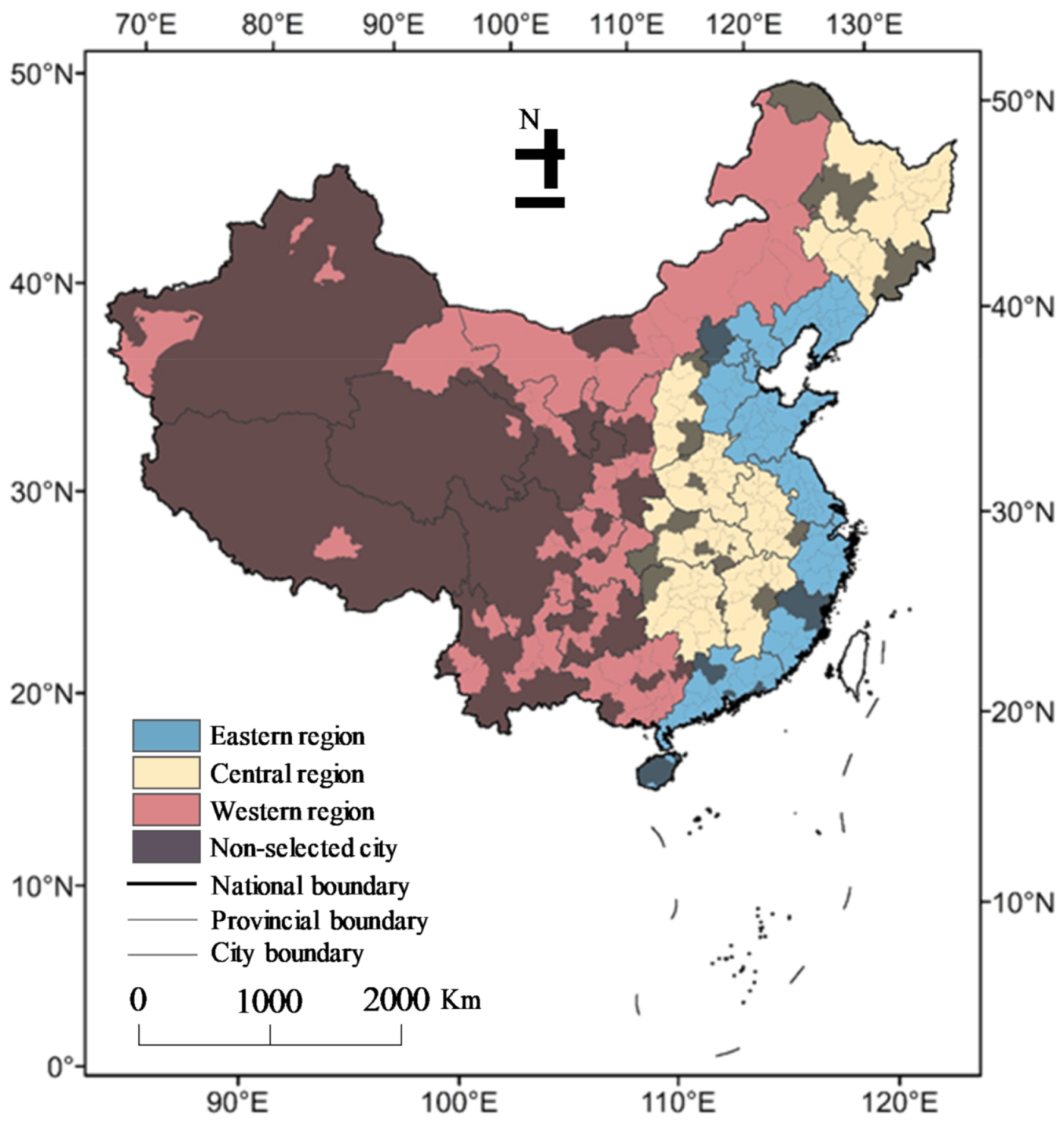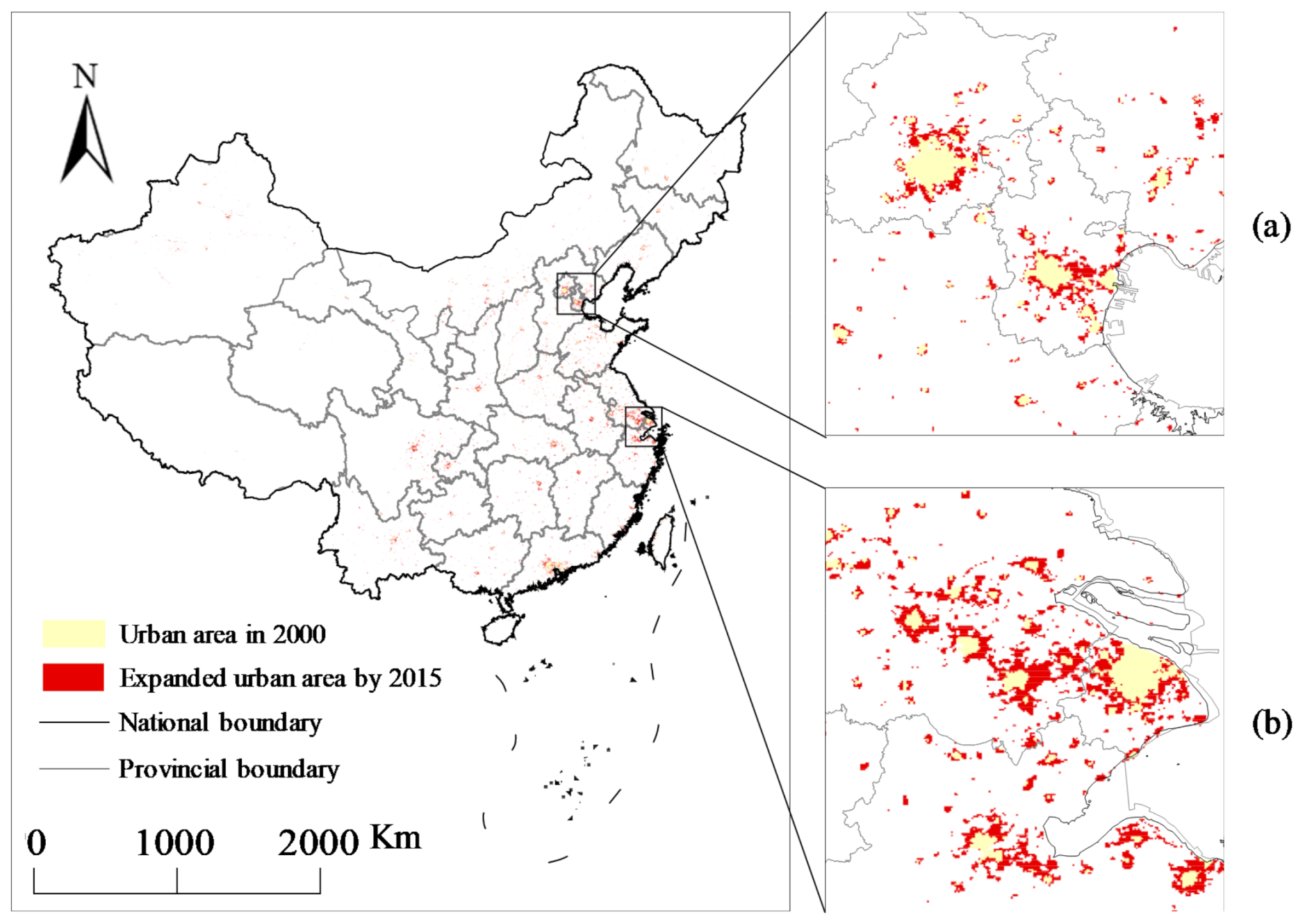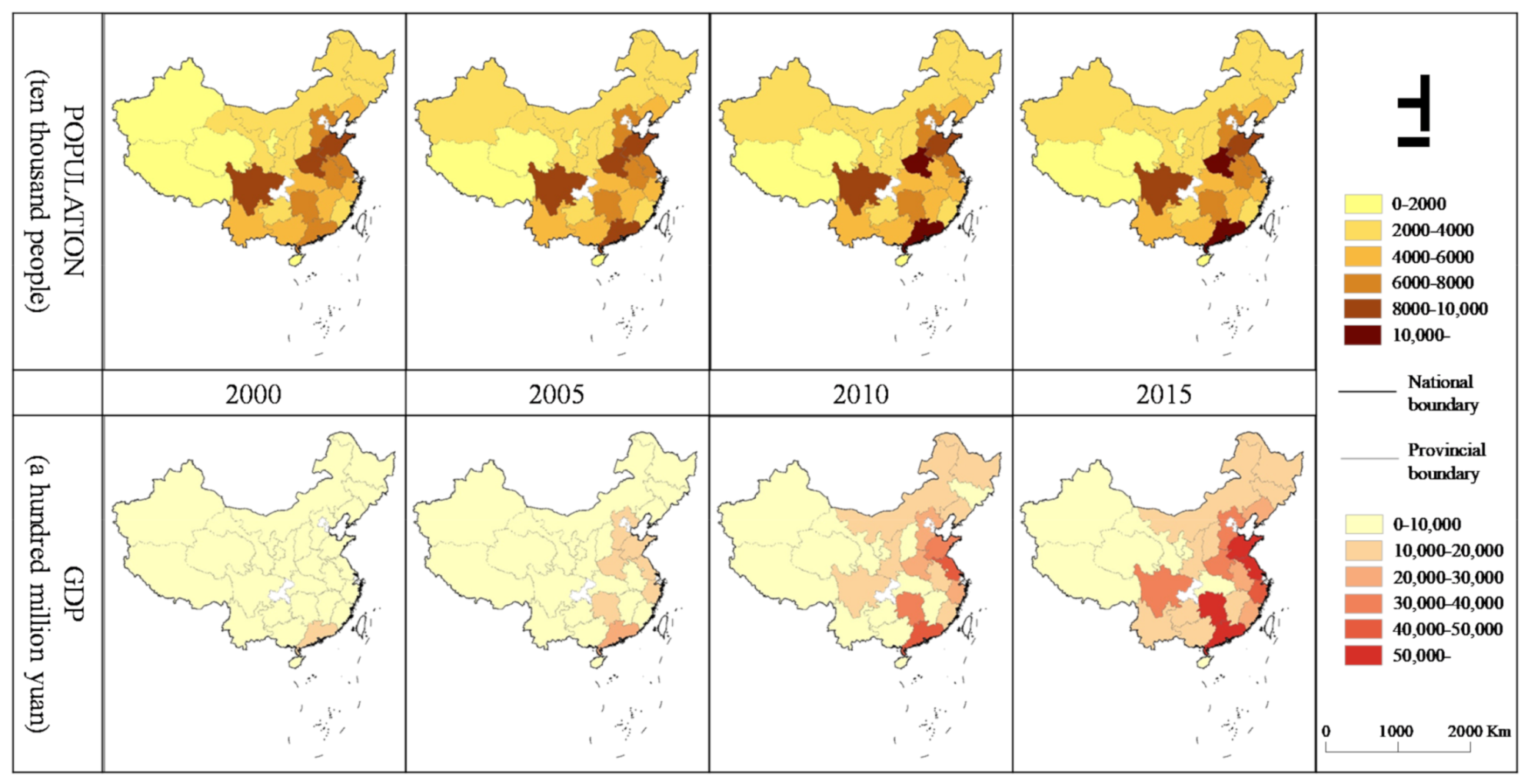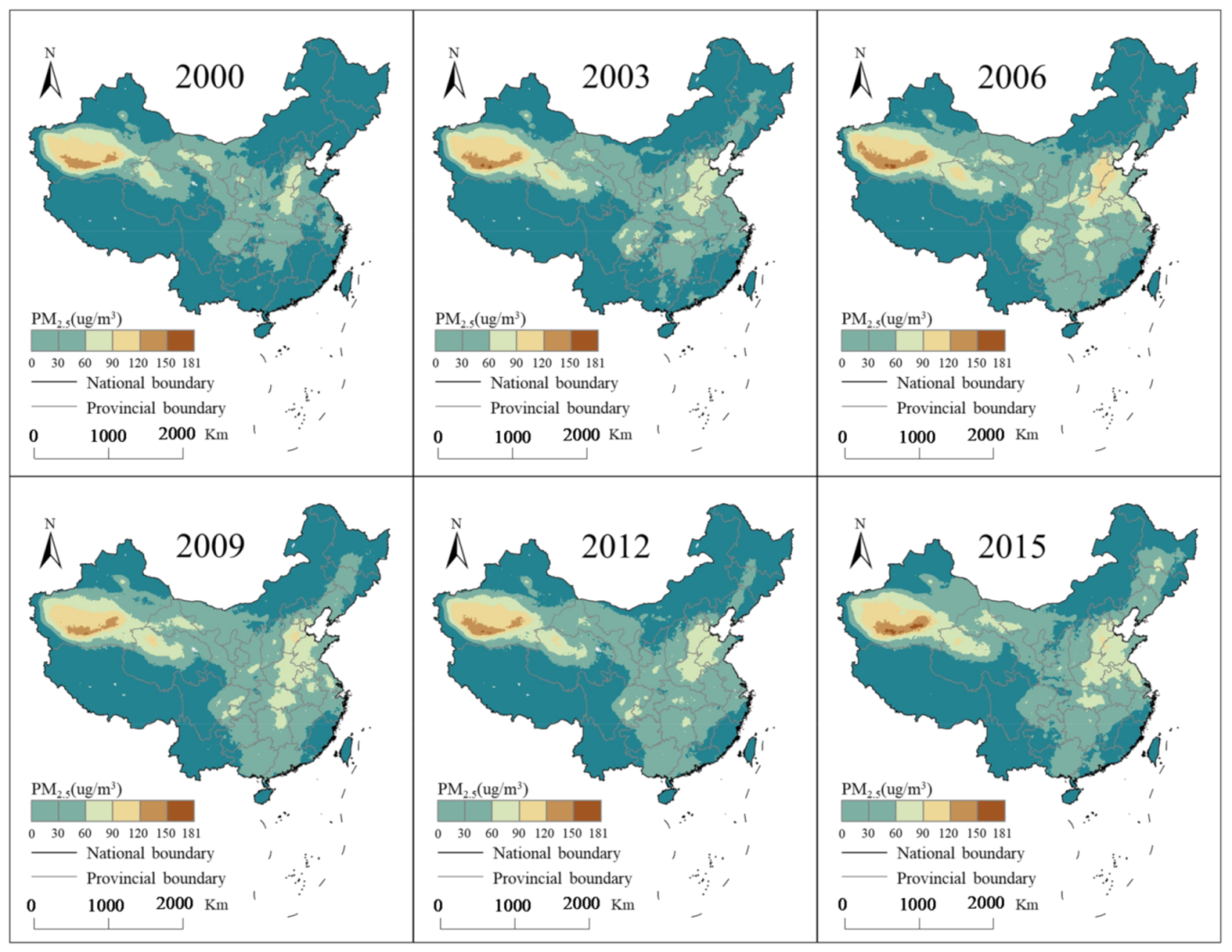The Effects of Urban Forms on the PM2.5 Concentration in China: A Hierarchical Multiscale Analysis
Abstract
:1. Introduction
2. Materials and Methods
2.1. Study Area
2.2. UF Quantification
2.3. PM2.5 Data
2.4. Control Variables
2.5. Econometric Model
3. Results and Discussion
3.1. Spatiotemporal Analysis of the UF and PM2.5 Concentration
3.2. Correlations between the UF and PM2.5 Concentration in China
3.3. Scale Effect of the UF on the PM2.5 Concentration
3.4. Heterogeneity Analysis at the Different Scales
3.5. Limitations and Future Directions
4. Conclusions and Policy Implications
Author Contributions
Funding
Institutional Review Board Statement
Informed Consent Statement
Data Availability Statement
Acknowledgments
Conflicts of Interest
References
- Huang, Z.; Wei, Y.D.; He, C.; Li, H. Urban land expansion under economic transition in China: A multi-level modeling analysis. Habitat Int. 2015, 47, 69–82. [Google Scholar] [CrossRef]
- Chen, M.; Liu, W.; Tao, X. Evolution and assessment on China’s urbanization 1960–2010: Under-urbanization or over-urbanization? Habitat Int. 2013, 38, 25–33. [Google Scholar] [CrossRef]
- Zhao, Y.; Wang, S.; Aunan, K.; Seip, H.M.; Hao, J. Air pollution and lung cancer risks in China—A meta-analysis. Sci. Total Environ. 2006, 366, 500–513. [Google Scholar] [CrossRef] [PubMed]
- Alam, M.S.; Hyde, B.; Duffy, P.; McNabola, A. Analysing the Co-Benefits of transport fleet and fuel policies in reducing PM2.5 and CO2 emissions. J. Clean. Prod. 2018, 172, 623–634. [Google Scholar] [CrossRef]
- Chow, J.C.; Watson, J.G.; Lowenthal, D.H.; Solomon, P.A.; Magliano, K.L.; Ziman, S.D.; Richards, L.W. PM10 and PM2.5 compositions in California’s San Joaquin Valley. Aerosol Sci. 1993, 18, 105–128. [Google Scholar] [CrossRef] [Green Version]
- Pui, D.Y.; Chen, S.-C.; Zuo, Z. PM2.5 in China: Measurements, sources, visibility and health effects, and mitigation. Particuology 2014, 13, 1–26. [Google Scholar] [CrossRef]
- Fan, C.; Tian, L.; Zhou, L.; Hou, D.; Song, Y.; Qiao, X.; Li, J. Examining the impacts of urban form on air pollutant emissions: Evidence from China. J. Environ. Manag. 2018, 212, 405–414. [Google Scholar] [CrossRef]
- Hailin, W.; Zhuang, Y.; Ying, W.; Yele, S.; Hui, Y.; Zhuang, G.; Zhengping, H. Long-term monitoring and source apportionment of PM2.5/PM10 in Beijing, China. J. Environ. Sci. 2008, 20, 1323–1327. [Google Scholar]
- Ewing, R.H.; Pendall, R.; Chen, D.D. Measuring Sprawl and Its Impact; Smart Growth America: Washington, DC, USA, 2002; Volume 1. [Google Scholar]
- Bereitschaft, B.; Debbage, K. Urban form, air pollution, and CO2 emissions in large US metropolitan areas. Prof. Geogr. 2013, 65, 612–635. [Google Scholar] [CrossRef]
- Yuan, M.; Huang, Y.; Shen, H.; Li, T. Effects of urban form on haze pollution in China: Spatial regression analysis based on PM2.5 remote sensing data. Appl. Geogr. 2018, 98, 215–223. [Google Scholar] [CrossRef]
- Zhao, H.; Guo, S.; Zhao, H. Quantifying the impacts of economic progress, economic structure, urbanization process, and number of vehicles on PM2.5 concentration: A provincial panel data model analysis of China. Int. J. Environ. Res. Public Health 2019, 16, 2926. [Google Scholar] [CrossRef] [Green Version]
- Liu, Y.; Wu, J.; Yu, D.; Ma, Q. The relationship between urban form and air pollution depends on seasonality and city size. Environ. Sci. Pollut. Res. 2018, 25, 15554–15567. [Google Scholar] [CrossRef]
- Tao, Y.; Zhang, Z.; Ou, W.; Guo, J.; Pueppke, S.G. How does urban form influence PM2.5 concentrations: Insights from 350 different-sized cities in the rapidly urbanizing Yangtze River Delta region of China, 1998–2015. Cities 2020, 98, 102581. [Google Scholar] [CrossRef]
- Liu, Y.; Arp, H.P.H.; Song, X.; Song, Y. Research on the relationship between urban form and urban smog in China. Environ. Plan. B Urban Anal. City Sci. 2017, 44, 328–342. [Google Scholar] [CrossRef]
- Shi, K.; Wang, H.; Yang, Q.; Wang, L.; Sun, X.; Li, Y. Exploring the relationships between urban forms and fine particulate (PM2.5) concentration in China: A multi-perspective study. J. Clean. Prod. 2019, 231, 990–1004. [Google Scholar] [CrossRef]
- Shi, K.; Li, Y.; Chen, Y.; Li, L.; Huang, C. How does the urban form- PM2.5 concentration relationship change seasonally in Chinese cities? A comparative analysis between national and urban agglomeration scales. J. Clean. Prod. 2019, 239, 118088. [Google Scholar] [CrossRef]
- Feng, H.; Zou, B.; Tang, Y. Scale-and region-dependence in landscape- PM2.5 correlation: Implications for urban planning. Remote Sens. 2017, 9, 918. [Google Scholar] [CrossRef] [Green Version]
- Ma, Q.; He, C.; Wu, J. Behind the rapid expansion of urban impervious surfaces in China: Major influencing factors revealed by a hierarchical multiscale analysis. Land Use Policy 2016, 59, 434–445. [Google Scholar] [CrossRef]
- Parenteau, M.-P.; Sawada, M.C. The modifiable areal unit problem (MAUP) in the relationship between exposure to NO2 and respiratory health. Int. J. Health Geogr. 2011, 10, 58. [Google Scholar] [CrossRef] [Green Version]
- Arbia, G.; Petrarca, F. Effects of MAUP on spatial econometric models. Lett. Spat. Resour. Sci. 2011, 4, 173. [Google Scholar] [CrossRef]
- Fang, C.; Song, J.; Zhang, Q.; LI, M. The formation, development and spatial heterogeneity patterns for the structures system of urban agglomerations in China. Acta Geogr. Sin. Chin. Ed. 2005, 60, 827. (In Chinese) [Google Scholar]
- Chu, H.-J.; Huang, B.; Lin, C.-Y. Modeling the spatio-temporal heterogeneity in the PM10-PM2.5 relationship. Atmos. Environ. 2015, 102, 176–182. [Google Scholar] [CrossRef]
- Fang, C.; Wang, S.; Li, G. Changing urban forms and carbon dioxide emissions in China: A case study of 30 provincial capital cities. Appl. Energy 2015, 158, 519–531. [Google Scholar] [CrossRef]
- Stone, B., Jr. Urban sprawl and air quality in large US cities. J. Environ. Manag. 2008, 86, 688–698. [Google Scholar] [CrossRef]
- He, C.; Liu, Z.; Tian, J.; Ma, Q. Urban expansion dynamics and natural habitat loss in China: A multiscale landscape perspective. Glob. Chang. Biol. 2014, 20, 2886–2902. [Google Scholar] [CrossRef]
- McGarigal, K.; Cushman, S.A.; Ene, E. FRAGSTATS v4: Spatial Pattern Analysis Program for Categorical and Continuous Maps. Computer Software Program Produced by the Authors at the University of Massachusetts, Amherst. 2012. Available online: http://www.umass.edu/landeco/research/fragstats/fragstats.html (accessed on 11 August 2019).
- Van Donkelaar, A.; Martin, R.V.; Li, C.; Burnett, R.T. Regional estimates of chemical composition of fine particulate matter using a combined geoscience-statistical method with information from satellites, models, and monitors. Environ. Sci. Technol. 2019, 53, 2595–2611. [Google Scholar] [CrossRef] [Green Version]
- Van Donkelaar, A.; Martin, R.V.; Brauer, M.; Boys, B.L. Global fine particulate matter concentrations from satellite for long-term exposure 2 assessment 3. Assessment 2015, 3, 1–43. [Google Scholar]
- Rohde, R.A.; Muller, R.A. Air pollution in China: Mapping of concentrations and sources. PloS ONE 2015, 10, e0135749. [Google Scholar] [CrossRef]
- Han, L.; Zhou, W.; Pickett, S.T.; Li, W.; Li, L. An optimum city size? The scaling relationship for urban population and fine particulate (PM2.5) concentration. Environ. Pollut. 2016, 208, 96–101. [Google Scholar] [CrossRef]
- Lin, G.; Fu, J.; Jiang, D.; Hu, W.; Dong, D.; Huang, Y.; Zhao, M. Spatio-temporal variation of PM2.5 concentrations and their relationship with geographic and socioeconomic factors in China. Int. J. Environ. Res. Public Health 2014, 11, 173–186. [Google Scholar] [CrossRef] [Green Version]
- Shi, K.; Shen, J.; Wang, L.; Ma, M.; Cui, Y. A multiscale analysis of the effect of urban expansion on PM2.5 concentrations in China: Evidence from multisource remote sensing and statistical data. Build. Environ. 2020, 174, 106778. [Google Scholar] [CrossRef]
- Levin, A.; Lin, C.-F.; Chu, C.-S.J. Unit root tests in panel data: Asymptotic and finite-sample properties. J. Econom. 2002, 108, 1–24. [Google Scholar] [CrossRef]
- Shi, K.; Chen, Y.; Yu, B.; Xu, T.; Chen, Z.; Liu, R.; Li, L.; Wu, J. Modeling spatiotemporal CO2 (carbon dioxide) emission dynamics in China from DMSP-OLS nighttime stable light data using panel data analysis. Appl. Energy 2016, 168, 523–533. [Google Scholar] [CrossRef]
- Borenstein, M.; Hedges, L.V.; Higgins, J.P.; Rothstein, H.R. A basic introduction to fixed-effect and random-effects models for meta-analysis. Res. Synth. Methods 2010, 1, 97–111. [Google Scholar] [CrossRef]
- Wen, H.; Tao, Y. Polycentric urban structure and housing price in the transitional China: Evidence from Hangzhou. Habitat Int. 2015, 46, 138–146. [Google Scholar] [CrossRef]
- Bailliu, J.; Kruger, M.; Toktamyssov, A.; Welbourn, W. How fast can China grow? The Middle Kingdom’s prospects to 2030. Pac. Econ. Rev. 2019, 24, 373–399. [Google Scholar] [CrossRef] [Green Version]
- Hu, H. The distribution of population in China. Acta Geogr. Sin. 1935, 2, 32–74. (In Chinese) [Google Scholar]
- Zhou, L.; Zhou, C.; Yang, F.; Che, L.; Wang, B.; Sun, D. Spatio-temporal evolution and the influencing factors of PM2.5 in China between 2000 and 2015. J. Geogr. Sci. 2019, 29, 253–270. [Google Scholar] [CrossRef] [Green Version]
- Yan, D.; Lei, Y.; Shi, Y.; Zhu, Q.; Li, L.; Zhang, Z. Evolution of the spatiotemporal pattern of PM2.5 concentrations in China–A case study from the Beijing-Tianjin-Hebei region. Atmos. Environ. 2018, 183, 225–233. [Google Scholar] [CrossRef] [Green Version]
- Wang, S.; Zhou, C.; Wang, Z.; Feng, K.; Hubacek, K. The characteristics and drivers of fine particulate matter (PM2.5) distribution in China. J. Clean. Prod. 2017, 142, 1800–1809. [Google Scholar] [CrossRef]
- Maddala, G.S.; Wu, S. A comparative study of unit root tests with panel data and a new simple test. Oxf. Bull. Econ. Stat. 1999, 61, 631–652. [Google Scholar] [CrossRef]
- Gan, C.-H.; Zheng, R.-G. An empirical study on change of industrial structure and productivity growth since the reform and opening-up—A test for the structure-bonus hypotheses from 1978 to 2007 in China. China Ind. Econ. 2009, 2, 55–65. [Google Scholar]
- Wang, Z.; Jia, H.; Xu, T.; Xu, C. Manufacturing industrial structure and pollutant emission: An empirical study of China. J. Clean. Prod. 2018, 197, 462–471. [Google Scholar] [CrossRef]
- Wolfe, D.A. Economy; Society, The strategic management of core cities: Path dependence and economic adjustment in resilient regions. Camb. J. Reg. Econ. Soc. 2010, 3, 139–152. [Google Scholar] [CrossRef]
- Ou, J.; Liu, X.; Li, X.; Chen, Y. Quantifying the relationship between urban forms and carbon emissions using panel data analysis. Landsc. Ecol. 2013, 28, 1889–1907. [Google Scholar] [CrossRef]
- Tan, M. Climatic differences and similarities between Indian and East Asian Monsoon regions of China over the last millennium: A perspective based mainly on stalagmite records. Int. J. Speleol. 2007, 36, 3. [Google Scholar] [CrossRef] [Green Version]
- Jin, Q.; Fang, X.; Wen, B.; Shan, A. Spatio-temporal variations of PM2.5 emission in China from 2005 to 2014. Chemosphere 2017, 183, 429–436. [Google Scholar] [CrossRef]
- Guan, Q.; Cai, A.; Wang, F.; Yang, L.; Xu, C.; Liu, Z. Spatio-temporal variability of particulate matter in the key part of Gansu Province, Western China. Environ. Pollut. 2017, 230, 189–198. [Google Scholar] [CrossRef]
- Chen, Y.; Li, X.; Zheng, Y.; Guan, Y.; Liu, X. Estimating the relationship between urban forms and energy consumption: A case study in the Pearl River Delta, 2005–2008. Landsc. Urban Plan. 2011, 102, 33–42. [Google Scholar] [CrossRef]
- Doronzo, D.M.; de Tullio, M.D.; Pascazio, G.; Dellino, P.; Liu, G. On the interaction between shear dusty currents and buildings in vertical collapse: Theoretical aspects, experimental observations, and 3D numerical simulation. J. Volcanol. Geotherm. Res. 2015, 302, 190–198. [Google Scholar] [CrossRef]







| Year | STA | CA (km2) | NP | LPI (%) | LSI | ENN_MN | PLADJ (%) | COHESION | Population (a) | GDP (b) |
|---|---|---|---|---|---|---|---|---|---|---|
| 2000 | MIN | 400.000 | 2.000 | 0.000 | 1.500 | 5000.000 | 25.000 | 32.827 | 259.830 | 117.800 |
| MAX | 539,400.000 | 113.000 | 2.014 | 11.670 | 470,196.946 | 84.409 | 97.314 | 9488.000 | 10,741.250 | |
| MEAN | 82,784.615 | 32.346 | 0.181 | 5.735 | 56,061.794 | 73.487 | 82.181 | 4363.937 | 3389.905 | |
| STD | 104,858.622 | 26.361 | 0.376 | 2.617 | 86,408.089 | 11.103 | 11.128 | 2560.109 | 2810.902 | |
| 2005 | MIN | 2000.000 | 3.000 | 0.001 | 2.188 | 10,909.704 | 37.500 | 51.233 | 280.310 | 248.800 |
| MAX | 716,300.000 | 148.000 | 2.650 | 14.879 | 469,413.836 | 83.666 | 97.564 | 9768.000 | 22,557.370 | |
| MEAN | 141,515.385 | 54.385 | 0.296 | 7.849 | 46,840.972 | 73.505 | 84.960 | 4515.563 | 6655.292 | |
| STD | 152,436.225 | 36.338 | 0.513 | 3.256 | 85,780.566 | 9.020 | 8.343 | 2683.922 | 5949.370 | |
| 2010 | MIN | 3200.000 | 5.000 | 0.001 | 2.667 | 9472.759 | 50.000 | 62.002 | 300.220 | 507.460 |
| MAX | 781,900.000 | 161.000 | 3.352 | 16.237 | 126,236.657 | 83.745 | 98.068 | 10,440.940 | 46,036.250 | |
| MEAN | 175,407.692 | 63.308 | 0.387 | 8.737 | 30,699.052 | 74.230 | 86.224 | 4674.063 | 14,773.905 | |
| STD | 173,214.016 | 42.025 | 0.672 | 3.558 | 23,359.325 | 7.211 | 7.037 | 2845.617 | 13,010.691 | |
| 2015 | MIN | 4500.000 | 12.000 | 0.001 | 3.643 | 6628.607 | 43.333 | 57.727 | 323.970 | 1026.390 |
| MAX | 894,100.000 | 444.000 | 3.548 | 20.360 | 45,108.049 | 82.502 | 97.652 | 10,849.000 | 72,812.550 | |
| MEAN | 239,873.077 | 159.385 | 0.447 | 12.313 | 15,191.780 | 69.440 | 83.358 | 4794.344 | 24,381.921 | |
| STD | 198,278.027 | 99.308 | 0.718 | 4.092 | 8163.476 | 8.578 | 8.193 | 2930.681 | 21,446.614 |
| Year | STA | CA (km2) | NP | LPI (%) | LSI | ENN_MN | PLADJ (%) | COHESION | Population (a) | GDP (b) |
|---|---|---|---|---|---|---|---|---|---|---|
| 2000 | MIN | 1.000 | 1.000 | 0.006 | 1.000 | 2000.000 | 0.000 | 0.000 | 15.960 | 179,307.000 |
| MAX | 1341.000 | 16.000 | 30.122 | 4.691 | 159,708.973 | 91.406 | 97.870 | 3091.090 | 45,511,500.000 | |
| MEAN | 99.282 | 3.489 | 1.156 | 2.002 | 27,942.287 | 67.689 | 75.962 | 437.640 | 4,132,103.206 | |
| STD | 178.799 | 2.800 | 3.329 | 0.824 | 26,968.348 | 15.390 | 15.033 | 333.963 | 5,072,992.580 | |
| 2005 | MIN | 3.000 | 1.000 | 0.008 | 1.000 | 2000.000 | 27.778 | 35.317 | 17.220 | 695,200.000 |
| MAX | 1990.000 | 24.000 | 37.932 | 6.151 | 159,708.973 | 89.088 | 98.679 | 3169.160 | 91,541,800.000 | |
| MEAN | 167.179 | 5.830 | 1.741 | 2.660 | 23,666.228 | 70.455 | 80.578 | 452.159 | 7,883,789.645 | |
| STD | 267.914 | 4.541 | 4.473 | 1.100 | 19,797.264 | 10.614 | 10.279 | 342.462 | 10,589,234.331 | |
| 2010 | MIN | 7.000 | 1.000 | 0.008 | 1.000 | 2000.000 | 27.778 | 34.051 | 21.800 | 1,632,777.000 |
| MAX | 2120.000 | 32.000 | 44.203 | 7.281 | 159,708.973 | 88.797 | 98.916 | 3303.450 | 171,659,800.000 | |
| MEAN | 205.614 | 6.646 | 2.110 | 2.935 | 21,795.357 | 71.442 | 82.124 | 466.032 | 17,404,371.670 | |
| STD | 310.517 | 5.134 | 5.244 | 1.190 | 18,472.615 | 9.526 | 9.429 | 333.169 | 21,837,487.314 | |
| 2015 | MIN | 11.000 | 2.000 | 0.008 | 1.500 | 2000.000 | 31.250 | 48.759 | 20.250 | 1,900,441.000 |
| MAX | 6498.100 | 2909.000 | 48.280 | 62.865 | 85,519.693 | 89.818 | 98.756 | 3371.840 | 251,234,500.000 | |
| MEAN | 561.008 | 27.610 | 2.467 | 4.090 | 14,475.278 | 69.050 | 81.098 | 478.639 | 28,409,807.169 | |
| STD | 433.857 | 194.195 | 5.727 | 4.227 | 11,252.983 | 9.700 | 9.170 | 343.803 | 35,861,986.988 |
| Year | STA | PM2.5 (μg·m−3) at the Provincial Scale | PM2.5 (μg·m−3) at the City Scale |
|---|---|---|---|
| 2000 | MIN | 10.972 | 6.000 |
| MAX | 75.282 | 92.607 | |
| MEAN | 40.253 | 39.547 | |
| STD | 15.885 | 17.999 | |
| 2005 | MIN | 14.353 | 12.500 |
| MAX | 81.991 | 99.800 | |
| MEAN | 50.792 | 50.620 | |
| STD | 17.303 | 18.455 | |
| 2010 | MIN | 13.462 | 11.000 |
| MAX | 85.721 | 123.773 | |
| MEAN | 52.393 | 52.994 | |
| STD | 18.742 | 20.170 | |
| 2015 | MIN | 12.455 | 12.500 |
| MAX | 80.981 | 92.900 | |
| MEAN | 48.652 | 49.613 | |
| STD | 17.046 | 18.529 |
| Variables | Provincial Scale | City Scale | ||||
|---|---|---|---|---|---|---|
| LLC | ADF | PPS | LLC | ADF | PPS | |
| CA | −2.79 *** | 59.65 | 62.02 | −10.99 *** | 780.66 *** | 824.36 *** |
| NP | 10.64 | 20.57 | 9.13 | 1.68 | 555.78 *** | 464.29 *** |
| LPI | −5.59 *** | 128.58 *** | 152.14 *** | −22.21 *** | 1041.73 *** | 1087.70 *** |
| LSI | −10.22 *** | 108.60 *** | 106.70 *** | −31.87 *** | 1294.65 *** | 1353.57 *** |
| ENN_MN | −11.39 *** | 141.47 *** | 135.21 *** | −2.93 *** | 1379.38 *** | 1479.34 *** |
| PLADJ | −12.51 *** | 147.87 *** | 147.79 *** | −39.98 *** | 1590.01 *** | 1716.48 *** |
| COHESION | −4.60 *** | 89.94 *** | 103.14 *** | −40.31 *** | 1444.59 *** | 1640.67 *** |
| Population | 4.68 | 72.94 ** | 88.48 *** | −91.11 *** | 903.95 *** | 977.43 *** |
| GDP | 6.23 | 21.86 | 32.94 | 23.96 | 250.40 | 255.33 |
| PM2.5 | −14.47 *** | 205.54 *** | 284.74 *** | −74.50 *** | 2753.93 *** | 3578.73 *** |
| Variable | Coefficient (Provincial Scale) | Coefficient (City Scale) | ||
|---|---|---|---|---|
| Fixed Effect | Random Effect | Fixed Effect | Random Effect | |
| CA | 0.000149 *** | −2.19 × 10−5 | 7.16 × 10−5 *** | 5.71 × 10−5 ** |
| NP | −0.033436 ** | −0.112956 *** | −0.110307 * | −0.080818 |
| LPI | −15.85242 *** | −7.337464 | −0.377232 *** | −0.403132 *** |
| LSI | −2.106767 *** | 2.545653 *** | −2.286485 *** | −2.150084 *** |
| ENN_MN | −2.44 × 10−5 *** | 8.70 × 10−5 *** | −9.44 × 10−5 *** | −9.61 × 10−5 *** |
| PLADJ | −0.495721 | 0.654456 * | 0.188681 | 0.124223 |
| COHESION | 0.727133 ** | −0.797569 ** | −0.041554 | 0.041326 |
| Population | 5.13 × 10−5 | 0.003239 *** | 0.001401 | 0.000833 |
| GDP | −6.96 × 10−5 | 0.000247 *** | 2.96 × 10−5 | 6.30 × 10−5 |
| R2 | 0.467900 | 0.389188 | 0.097361 | 0.031573 |
| Adjusted R2 | 0.432427 | 0.372376 | 0.089557 | 0.028002 |
| F-statistic | 13.19020 | 23.15028 | 12.47607 | 8.842340 |
| Probability (F-statistic) | 0.000000 | 0.000000 | 0.000000 | 0.000000 |
| Variable | Eastern Provinces | Central Provinces | Western Provinces | |||
|---|---|---|---|---|---|---|
| Fixed Effect | Random Effect | Fixed Effect | Random Effect | Fixed Effect | Random Effect | |
| CA | −0.000104 *** | −8.70 × 10−5 *** | −0.000226 * | −0.000225 * | 2.40 × 10−5 | −5.36 × 10−5 |
| NP | −0.164934 *** | −0.192234 *** | −0.001218 * | −0.001613 ** | −0.152360 *** | −0.128675 *** |
| LPI | 13.54699 * | 9.878880 *** | 90.60625 *** | 80.68187 *** | 12.26049 | 21.00478 |
| LSI | 9.744146 *** | 9.632921 ** | 7.981017 ** | 7.219544 ** | −1.946943 | −0.694878 |
| ENN_MN | −1.64 × 10−5 | −1.90 × 10−5 | −3.85 × 10−5 | −0.000120 | 4.69 × 10−5 *** | 5.01 × 10−5 *** |
| PLADJ | 4.072971 *** | 4.236901 *** | 3.951412 *** | 3.958976 *** | −0.652470 | −0.499892 |
| COHESION | −5.321512 *** | −5.188210 *** | −2.776398 *** | −2.657545 *** | 1.440029 * | 1.267429 * |
| Population | 5.52 × 10−5 | −1.63 × 10−5 | 0.003348 *** | 0.003601 *** | −0.001530 * | −0.001618 ** |
| GDP | 0.000312 ** | 0.000252 ** | 7.30 × 10−5 | −1.12 × 10−5 | 0.001672* | 0.001992 *** |
| R2 | 0.912831 | 0.857158 | 0.901512 | 0.866379 | 0.509384 | 0.487694 |
| Adjusted R2 | 0.890507 | 0.843481 | 0.871537 | 0.851533 | 0.423527 | 0.452764 |
| F-statistic | 40.89031 | 62.67433 | 30.07586 | 58.35489 | 5.932886 | 13.96203 |
| Probability (F-statistic) | 0.000000 | 0.000000 | 0.000000 | 0.000000 | 0.000000 | 0.000000 |
| Variable | Eastern Cities | Central Cities | Western Cities | |||
|---|---|---|---|---|---|---|
| Fixed Effect | Random Effect | Fixed Effect | Random Effect | Fixed Effect | Random Effect | |
| CA | 0.000107 *** | 7.24 × 10−5 ** | 0.000152 *** | 0.000119 * | −0.000173 | −0.000363 ** |
| NP | −1.116592 *** | −1.075780 *** | −0.307969 ** | −0.237743 | 0.569279 *** | 0.543614 *** |
| LPI | −0.564496 *** | −0.582432 *** | −1.083794 * | −0.927409 * | −3.817160 *** | −3.157423 *** |
| LSI | 2.055063 | 3.001070 ** | −1.340814 * | −1.251308 | −8.881376 *** | −7.310335 *** |
| ENN_MN | −0.000106 ** | −7.86 × 10−5 | −0.000150 * | −0.000152 *** | −6.28 × 10−5 * | −7.96 × 10−5 ** |
| PLADJ | −0.097256 | −0.192349 | 0.319850 *** | 0.284170 * | 0.323929 | 0.259471 |
| COHESION | 0.102646 | 0.202534 | −0.274463 ** | −0.224378 | 0.479088 | 0.647384 ** |
| Population | 0.010097 *** | 0.008177 *** | 0.004254 ** | 0.003932 ** | −0.006029 ** | −0.007334 *** |
| GDP | 5.34 × 10−5 | 6.69 × 10−5 ** | 1.02 × 10−5 | 1.34 × 10−5 ** | 2.14 × 10−5 | 4.59 × 10−5 *** |
| R2 | 0.103133 | 0.045942 | 0.137810 | 0.059979 | 0.213630 | 0.150234 |
| Adjusted R2 | 0.086073 | 0.038248 | 0.127557 | 0.055221 | 0.172449 | 0.131716 |
| F-statistic | 6.045331 | 5.971130 | 13.44152 | 12.60530 | 5.187533 | 8.112916 |
| Probability (F-statistic) | 0.000000 | 0.000000 | 0.000000 | 0.000000 | 0.000000 | 0.000000 |
Publisher’s Note: MDPI stays neutral with regard to jurisdictional claims in published maps and institutional affiliations. |
© 2021 by the authors. Licensee MDPI, Basel, Switzerland. This article is an open access article distributed under the terms and conditions of the Creative Commons Attribution (CC BY) license (https://creativecommons.org/licenses/by/4.0/).
Share and Cite
Jiang, M.; Wu, Y.; Chang, Z.; Shi, K. The Effects of Urban Forms on the PM2.5 Concentration in China: A Hierarchical Multiscale Analysis. Int. J. Environ. Res. Public Health 2021, 18, 3785. https://doi.org/10.3390/ijerph18073785
Jiang M, Wu Y, Chang Z, Shi K. The Effects of Urban Forms on the PM2.5 Concentration in China: A Hierarchical Multiscale Analysis. International Journal of Environmental Research and Public Health. 2021; 18(7):3785. https://doi.org/10.3390/ijerph18073785
Chicago/Turabian StyleJiang, Mingyue, Yizhen Wu, Zhijian Chang, and Kaifang Shi. 2021. "The Effects of Urban Forms on the PM2.5 Concentration in China: A Hierarchical Multiscale Analysis" International Journal of Environmental Research and Public Health 18, no. 7: 3785. https://doi.org/10.3390/ijerph18073785





